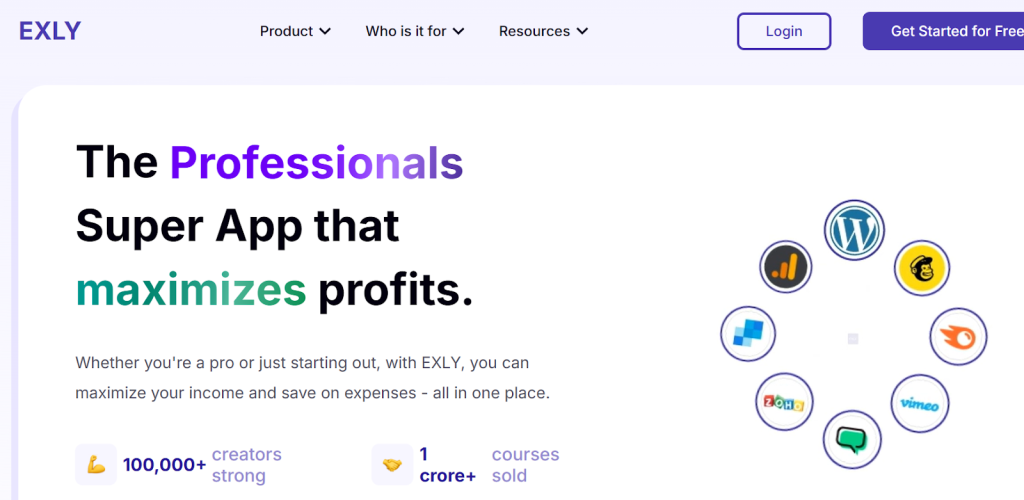The online education revolution is here—are you ready to be a part of it, or will you stay a spectator?
With $7.57 billion in revenue by 2025 and 309+ million learners worldwide, the digital classroom is the fastest way to monetize your expertise.
Take Ankur Warikoo, for example. He started by teaching small groups online and later launched his education startup, WebVeda. Today, WebVeda contributes a massive ₹9.5 crore to Ankur Warikoo’s annual revenue. His success is proof that online teaching can not only be fulfilling but also highly profitable.
Do you want to know how you can do that too? Well, we’ve got the perfect guide for you!
In this blog, you’ll discover:
- Why is online teaching a career that works around your lifestyle?
- How to choose the right niche and create courses that sell?
- The best platforms to get started and grow your business
- Bonus Strategies to Skyrocket Your Earnings
- Overcoming Challenges in Online Teaching
If you’re ready to start your journey in online teaching, keep reading!
Why Online Teaching is the Perfect Career Choice for You?

As the online teaching landscape grows, it’s becoming clear why this is the perfect career choice for creators like you. From flexibility and earning potential to the ability to work from anywhere, online teaching offers unique advantages that traditional jobs simply can’t match. Let’s explore why online teaching could be the ideal career path for you:
1. Flexibility at Its Best
You can teach from anywhere, be it your home, a café, or while traveling. No more 9-5 grind. With online teaching, you can choose your working hours and work on your terms.
2. Set Your Own Pace
Unlike traditional teaching jobs, where the curriculum is set for you, online teaching gives you the freedom to decide how fast or slow you want to go. You can cater to your students’ pace and provide personalized attention.
3. No Huge Investment Needed
Starting an online teaching business doesn’t require big investments in equipment or infrastructure. All you need is a laptop, an internet connection, and the desire to teach. It’s a low-cost way to enter the education field.
4. Massive Demand in India
The demand for online courses in India has increased drastically. More students are turning to the internet for education, whether it’s for upskilling, preparing for exams, or learning new hobbies. This creates a huge market for creators like you.
5. Monetize Your Expertise
You already have knowledge or skills that others want to learn. Online teaching allows you to turn that expertise into a profitable business, helping others while earning money in the process.
6. Global Reach
Unlike traditional classrooms that limit you to one geographic location, online teaching lets you connect with students from across India, and the world. You can build a global community around your courses.
7. Scalable Income Potential
One of the best things about teaching online is that it’s scalable. As you grow, you can offer more courses, set up memberships, or host paid webinars. Your income potential grows with your business.
How to Teach Online and Earn Money?

Getting started with online teaching in India is easier than you might think. The digital landscape has made it possible for anyone with knowledge and a passion for teaching to create and sell courses, host live classes, and build a community of learners.
Here’s a simple roadmap to help you start earning money by teaching online:
1. Choose Your Niche
The first step in teaching online is figuring out what you want to teach. Your niche is crucial because it defines your target audience and helps you create tailored content that resonates with your students. Here’s how to do it:
- Identify Your Expertise and Passion: Consider what you’re truly passionate about and skilled at. Whether it’s teaching fitness, language, or digital marketing, your enthusiasm will shine through in your content.
- Research Market Demand: It’s essential to pick a niche that people are actually searching for. Take a look at online learning platforms, search engines, and social media to see what topics are trending or underserved.
For example, fitness has always been popular, but specific niches like “postpartum fitness” or “home workouts for beginners” could target a smaller, more engaged audience.
- Evaluate Competition: While it’s important to find a niche that interests you, it’s equally important to assess how much competition exists in that space. Aim for a niche that’s popular but not oversaturated.
Pro Tip: Once you’ve laid the groundwork, take it further with Webinars or surveys to see surveys to test how well your idea resonates with your audience.
You can also check out a blog on (How to Use Webinars to Sell Courses Online) for a deeper dive.
2. Pick the Right Platform
Once you’ve chosen your niche, the next step is selecting the platform where you’ll deliver your courses. Picking the right platform can save you time and effort, so it’s important to choose wisely.
- All-in-One Solution vs. Dedicated Course Platform: You could either use a dedicated course platform like Udemy or Skillshare, or opt for a more flexible solution like Exly, which lets you create, manage, and market your courses, along with handling payments and student management all in one place.
- Consider Your Needs: Think about what features are essential for your teaching style. If you plan on having live sessions, choose a platform with integrated video conferencing . If your course is more about content consumption, focus on platforms that support video and downloadable resources.
- Ease of Use: Make sure the platform is user-friendly for both you and your students. It should be easy to upload content, manage student progress, and offer support.
3. Create Your Course
Now that you’ve chosen the platform, it’s time to start creating your course. This is where you’ll transform your knowledge into structured lessons that will benefit your students.
- Organize Your Content: Break your content into modules and lessons. Each lesson should be focused on a specific topic or skill that builds on the previous one. For example, in a fitness course, you might start with the basics (warm-ups) and progress to more advanced exercises.
- Engagement Is Key: Use a variety of content formats like video tutorials, quizzes, assignments, and downloadable resources to keep your students engaged. Offering interactive elements helps students retain information better.
- Professional Quality: Invest in decent recording equipment. Good lighting, clear audio, and professional-looking videos will make your course more appealing and credible to students.
Also Read: Best Platforms for Online Course Creation in 2025
4. Set Your Pricing
Pricing your course is one of the most crucial decisions. Set it too high, and you may scare off potential students; too low, and you might undervalue your expertise. Here’s how to find the right price:
- Consider Your Content: If you’re offering specialized knowledge or advanced content, you can price your course higher. If it’s introductory content, a lower price point might be more appropriate.
- Research the Competition: Look at similar courses and see what they’re charging. This will help you gauge the average price in your niche and find a competitive rate.
- Offer Pricing Tiers: Many successful course creators use tiered pricing. For example, a basic course might cost ₹1,000, while a premium version with additional resources and 1-on-1 coaching could be ₹5,000.
5. Promote Your Course
Now that your course is ready, it’s time to market it. Without promotion, even the best course can go unnoticed.
- Leverage Social Media: Social platforms like Instagram, Facebook, and LinkedIn are great for promoting your course. Share snippets of your lessons, student testimonials, and behind-the-scenes footage to attract potential students.
- Create Engaging Content: Start a blog, YouTube channel, or podcast related to your niche. This helps establish you as an expert in your field while providing free value to your audience.
- Paid Ads and SEO: If you have the budget, consider running ads on Facebook or Google to target your ideal audience. Don’t forget to optimize your website and course pages for SEO so they show up in search results when people look for topics in your niche.
Don’t Skip: Steps to Grow and Scale Your Online Course Business in 2025
6. Interact and Engage with Your Students
Teaching online isn’t just about delivering content, it’s about building relationships with your students. The more connected they feel to you, the more likely they are to stay engaged and recommend your courses.
- Live Sessions and Q&A: Hold live sessions where you can interact directly with your students, answer their questions, and provide personalized feedback. This boosts student retention and satisfaction.
- Create a Community: Consider setting up a private Facebook group or a community forum where students can interact with each other, share progress, and ask questions. This fosters a sense of belonging and encourages students to stay engaged.
- Consistent Feedback: Regularly check in with your students, answer their questions, and provide constructive feedback on their work. The more interaction you have, the more invested they will be in completing your course.
Also Read: 8 Tips You Should Follow for an Engaging Online Course Content
Psst! Teaching online isn’t just about courses. Here are 8 clever ways to get paid for your knowledge. #3 surprises most beginners!
Different Ways You Can Teach Online and Make Money
The beauty of teaching online is that there are several ways to monetize your knowledge. Whether you prefer a one-time payment model or a recurring income stream, there are multiple options available.
Let’s break down some of the most effective ways you can earn money by teaching online:
1. Sell Pre-recorded Online Courses
One of the most popular methods of making money online is by creating and selling pre-recorded courses. These can be sold on platforms like Udemy, Skillshare, or your own website.
- How it works: You create a course on a specific topic, record the content, and upload it for students to purchase.
- Pros: Once the course is created, it can continue to sell and generate income with minimal effort. This is a form of passive income.
- Example: A coding course for beginners or a yoga program for stress relief.
Your pre-recorded course could make money 24/7. Exly automates everything.
2. Offer Live Online Classes or Coaching
If you enjoy the interaction and engagement with students, offering live online classes or coaching can be a rewarding way to make money.
- How it works: You conduct live lessons via video conferencing platforms like Zoom or Google Meet, where students can interact with you in real-time.
- Pros: Higher engagement and personal interaction. You can charge a premium for live sessions or coaching.
- Example: One-on-one fitness coaching, language tutoring, or business consulting.
3. Membership or Subscription Models
With a membership or subscription model, you provide ongoing access to exclusive content, live classes, or a community. This creates a steady, recurring income stream.
- How it works: Students pay a monthly or yearly fee for access to your content and community. You can offer exclusive webinars, resources, or a VIP group for members.
- Pros: Recurring income, stronger community engagement, and the ability to create new content on a regular basis.
- Example: A monthly membership for exclusive cooking classes or a subscription service for weekly fitness challenges.
4. Offer Workshops and Masterclasses
Workshops and masterclasses are short, intensive courses that focus on a specific topic. These can be highly profitable, especially if you market them as exclusive, time-limited events.
- How it works: You host a live session (or a series of sessions) where you teach students a focused skill or topic.
- Pros: High-ticket pricing and the ability to attract students who are eager to learn in a condensed timeframe.
- Example: A weekend masterclass on digital marketing or a one-day workshop on painting techniques.
5. Create a Paid Community or Forum
If you enjoy creating a supportive learning environment, building a paid community can be a great way to teach and earn money. This model works well for subjects where students want continuous support and engagement.
- How it works: You create a private community (on platforms like Slack, Discord, or Facebook) where members pay for access. You can offer exclusive resources, regular Q&As, and community challenges.
- Pros: Community-based learning encourages student retention and interaction.
- Example: A fitness community where members can share progress, ask questions, and receive ongoing support.
6. Sell Educational Materials (E-books, Workbooks, Templates)
If you prefer to create supplemental learning resources, selling educational materials like e-books, workbooks, or templates is another effective way to earn money.
- How it works: You create and sell downloadable materials that supplement your courses or serve as standalone products. This can include study guides, templates, and worksheets.
- Pros: Low production costs and the ability to sell these materials alongside your courses for additional revenue.
- Example: Selling a photography workbook with step-by-step lessons or an e-book on personal finance tips.
Must Read: How to Create and Sell Profitable Courses Online
7. Corporate Training Programs
Offering online training programs to businesses is a great way to scale your teaching business and make money. Many companies are willing to pay for professional development programs to upskill their employees.
- How it works: You create and deliver tailored courses for businesses and their teams, either live or pre-recorded.
- Pros: Higher earning potential due to the larger budgets of corporate clients.
- Example: A leadership development program for a company’s managers or a tech training course for a team of developers.
8. Affiliate Marketing and Sponsored Content
If you already have an established audience, affiliate marketing and sponsored content can be a great way to earn money in addition to teaching.
- How it works: You promote tools, resources, or products related to your course content and earn a commission for every sale made through your affiliate link. Sponsored content is when brands pay you to promote their product or service.
- Pros: Extra income streams without additional work on your part.
- Example: A fitness coach promoting health supplements or a tech educator recommending coding tools.
Each of these methods has its own strengths, so it’s important to find what works best for you and your audience. Once you’ve chosen your monetization model, you can start focusing on building your student base and increasing your revenue.
If it feels like a lot to handle, don’t worry, there are tools that can make everything easier and help you earn more.
5 Best Online Teaching Tools to Earn Money
Managing your online teaching business doesn’t have to be complicated. The right tools can simplify everything, from course creation to student management and payment processing. Here are five of the best tools that can help you earn more, save time, and focus on teaching.
1. Teachable
Teachable is a user-friendly platform for creating, marketing, and selling online courses. It provides robust customization options for course design, and it’s particularly useful for creators who want to build a unique brand around their courses.
| Pros | Cons |
| Full control over branding and course design, making it easy to build a strong brand identity. | Transaction fees on lower-tier plans, which can impact earnings. |
| Integration with popular tools like Mailchimp and Stripe, allowing smooth course management. | The free plan has limited features, which may make scaling difficult. |
| Great for multimedia courses with video, quizzes, and assignments. | Some users find the pricing structure confusing, particularly with add-ons. |
2. Zoom
Zoom is a video conferencing tool commonly used for live classes, webinars, and one-on-one coaching. It’s perfect for interactive teaching where real-time communication with students is necessary.
| Pros | Cons |
| Excellent for live interactions with video, audio, and chat capabilities. | Does not have built-in features for course creation or student management. |
| Supports large audiences for webinars or group lessons. | The free version limits meeting times to 40 minutes, which can disrupt longer sessions. |
| Allows for session recording, which you can repurpose as content later. | Lacks functionality for ongoing course sales or marketing, requiring third-party integrations. |
3. Thinkific
Thinkific is a comprehensive platform for creating and selling online courses, providing full control over content delivery, student management, and pricing options. It’s known for its customization features and ability to scale with your business.
| Pros | Cons |
| No transaction fees, allowing you to keep more of your earnings. | Some users find the initial learning curve to be steep due to the platform’s wide range of features. |
| High level of customization, from course design to branding. | Limited marketing tools on the basic plans, so you’ll need third-party tools for advanced campaigns. |
| Great for adding features like gamification, quizzes, and certificates. | Some integrations are only available in higher pricing tiers, which may increase costs. |
4. Udemy
Udemy is one of the largest online learning platforms, offering a marketplace for courses across various categories. It’s an excellent choice if you want to reach a broad audience without needing to build your own marketing infrastructure.
| Pros | Cons |
| Massive built-in audience, which helps new instructors gain visibility quickly. | Udemy takes a significant commission on each sale (up to 50%), especially if you use their promotions. |
| Simple to use, with easy-to-follow course creation tools. | Limited control over pricing and discounts; you can’t charge more than Udemy’s suggested pricing tiers. |
| Offers tools for quizzes, assignments, and student feedback. | High competition within the marketplace can make it harder to stand out. |
5. Kajabi
Kajabi is a comprehensive platform that provides everything you need to create, market, and sell online courses. It’s great for creators who want to scale their teaching business quickly.
| Pros | Cons |
| All-in-one platform for course creation, marketing, and sales. | Higher cost compared to other platforms, especially for beginners. |
| Powerful automation tools for email marketing, student engagement, and sales funnels. | Somewhat complex for new users due to its feature-rich platform. |
| High-level customization for branding and course design. | Transaction fees may apply depending on the pricing plan. |
Well, guess what? We’ve got some bonus tips for you that’ll help you maximize your earnings and take your online teaching to the next level!
Bonus Tips to Maximize Your Earnings
Beyond choosing the right tools and creating great content, there are several additional strategies you can implement to boost your online teaching revenue. These tips will help you reach a larger audience, increase student retention, and ultimately increase your earnings:
1. Create a Signature Course or Program
Instead of offering general courses, consider creating a signature course that addresses a specific pain point for your audience. This course should be the cornerstone of your business, offering immense value that no one else provides.
- Why it works: A signature course creates exclusivity and positions you as an expert in your niche, allowing you to charge a premium price.
- Example: If you’re a personal finance educator, a “Complete Guide to Financial Independence” course could become your signature program that attracts students willing to invest more for specialized content.
2. Run Seasonal Promotions and Discounts
While the value of your course should never be compromised, offering limited-time discounts or special offers during peak seasons (such as New Year or back-to-school) can drive more enrollments.
- Why it works: People are more likely to purchase when they see an opportunity to save or gain access to something exclusive.
- Tip: Use platforms like Exly to create limited-time discount codes and track the success of each campaign.
Your first student could enroll tomorrow. Let’s make it happen. [Talk→]
3. Develop a Referral Program
Word-of-mouth is incredibly powerful, especially in the e-learning space. Offering a referral program can incentivize your current students to bring in new ones.
- Why it works: Students are likely to trust recommendations from people they know. A referral program encourages your existing students to act as brand ambassadors for your courses.
- Tip: Offer discounts, free content, or even cash rewards for every successful referral. This can turn your satisfied students into a continuous stream of leads.
4. Build an Email List for Continuous Engagement
An email list allows you to nurture relationships with your audience and keep them informed about new courses, promotions, and updates. Email marketing is one of the most effective ways to increase sales and retain customers.
- Why it works: By keeping your audience engaged, you’re able to continuously promote new products or offer discounts. An engaged email list can also drive higher conversion rates for future course sales.
- Tip: Offer a free mini-course or e-book in exchange for email subscriptions to build your list.
Every success comes with its challenges. Let’s take a look at the common obstacles you might face and how to overcome them.
Overcoming Challenges in Online Teaching
As an online educator, you’ll face a variety of challenges that may come your way. But don’t worry, every challenge has a solution! Let’s dive into some common hurdles and how to overcome them effectively:
1. Engaging Your Students
One of the biggest challenges online teachers face is keeping students engaged. Without the physical classroom environment, it’s easy for learners to lose focus or fall behind.
How to Overcome It:
- Interactive Content: Use quizzes, polls, and gamified lessons to keep students engaged.
- Regular Feedback: Providing timely feedback helps students stay motivated and feel supported.
- Live Sessions: Offering live Q&A sessions and group discussions helps keep things interactive.
2. Technical Issues
Nothing is more frustrating than technical problems during a class. Whether it’s poor video quality, audio issues, or connectivity problems, these issues can disrupt the flow of your lessons.
How to Overcome It:
- Test Everything: Always do a trial run before your session to ensure your tech is working.
- Backup Plans: Have an alternative communication method ready, like chat or email, in case of connectivity issues.
- Invest in Good Equipment: Good quality microphones, cameras, and a reliable internet connection can save you from common tech problems.
3. Time Management
Online teaching may seem flexible, but balancing course creation, student management, and marketing can quickly overwhelm you.
How to Overcome It:
- Create a Schedule: Plan your lessons, marketing tasks, and content creation ahead of time.
- Use Automation: Automate admin tasks such as email marketing, payments, and student follow-ups to save time.
- Outsource: If possible, outsource tasks that are time-consuming, like video editing or marketing, so you can focus on teaching.
4. Student Motivation and Retention
Getting students to complete your course can be challenging, especially when they lose interest or motivation halfway through.
How to Overcome It:
- Set Clear Goals: Help students set goals at the beginning of the course and remind them of their progress throughout.
- Offer Incentives: Provide certificates, bonuses, or exclusive content to students who complete the course.
- Foster Community: Create a sense of community through group chats, forums, or student-only Facebook groups to keep students connected and motivated.
5. Managing Diverse Learners
You’ll encounter students with different learning styles, backgrounds, and skill levels. This can make it tough to keep everyone on the same page.
How to Overcome It:
- Personalized Learning Paths: Offer different levels of content (beginner, intermediate, advanced) to accommodate all students.
- Clear Communication: Make sure your instructions and expectations are clear and accessible for everyone.
- Provide Additional Resources: Offer extra materials for those who need more help, like video tutorials or reading materials.
6. Dealing with Negative Feedback
Handling negative feedback or criticism can be difficult, especially if you take it personally.
How to Overcome It:
- Stay Professional: Take a step back and view feedback as a tool for improvement rather than a personal attack.
- Learn from It: Use constructive criticism to improve your courses, teaching methods, and student engagement.
- Respond Positively: Acknowledge the feedback and show that you’re working to improve. This builds trust with your students.
While the challenges of online teaching are real, Exly is here to make it easier for you. Let’s take a look at how Exly can specifically help you with the hurdles we just discussed.
Why Exly is Your Perfect Partner for Online Teaching?

Exly is more than just a course creation tool, it’s your complete business partner. From seamless course delivery to marketing automation, Exly empowers you to build, grow, and scale your online teaching business effortlessly.
By using Exly, you can:
- Create and market courses with ease.
- Engage students through live sessions and interactive content.
- Save time with automated student management and payment systems.
- Track progress, collect feedback, and continuously improve your offerings.
Whether you’re just starting out or looking to take your online teaching business to the next level, Exly has everything you need to succeed.
Start to Earn Money by Teaching Online
Teaching online is your chance to share what you know and earn money while doing it. Whether you’re teaching fitness, cooking, or tech, there’s a growing community of students just waiting to learn from you. Plus, you get to do it all from the comfort of your home.
But here’s the secret: it’s not just about creating great courses. You need the right tools to manage everything. That’s where Exly comes in. It makes course creation, student management, and payments super easy, so you can focus on making your content even better.
So, what are you waiting for? Your knowledge is valuable, and there’s no better time to start sharing it. Let Exly help you get started and grow your teaching business. And yes, you can still wear sweatpants!
Over 1 Crore+ Courses Sold – Be Next!
Join the league of top online educators & grow your earnings. Create Your Course Now





